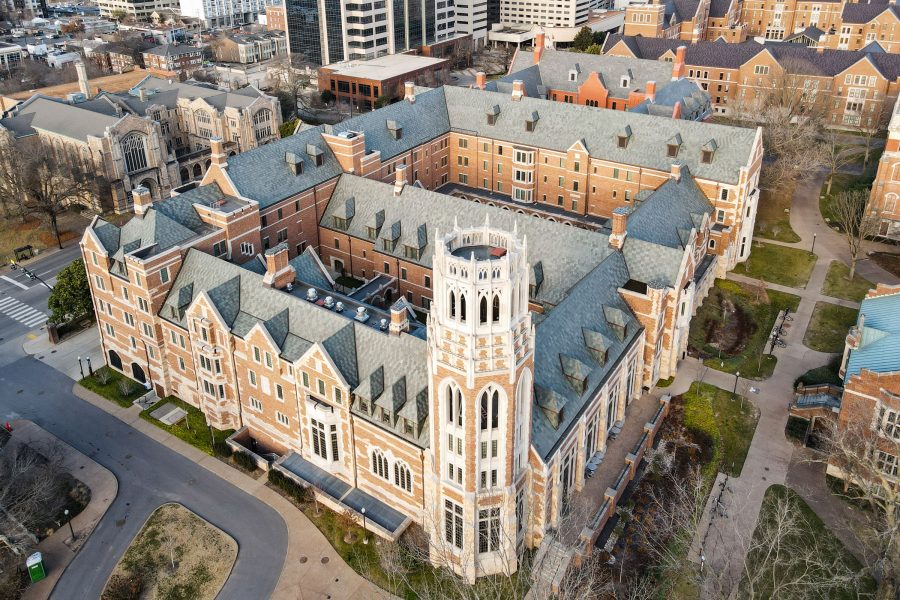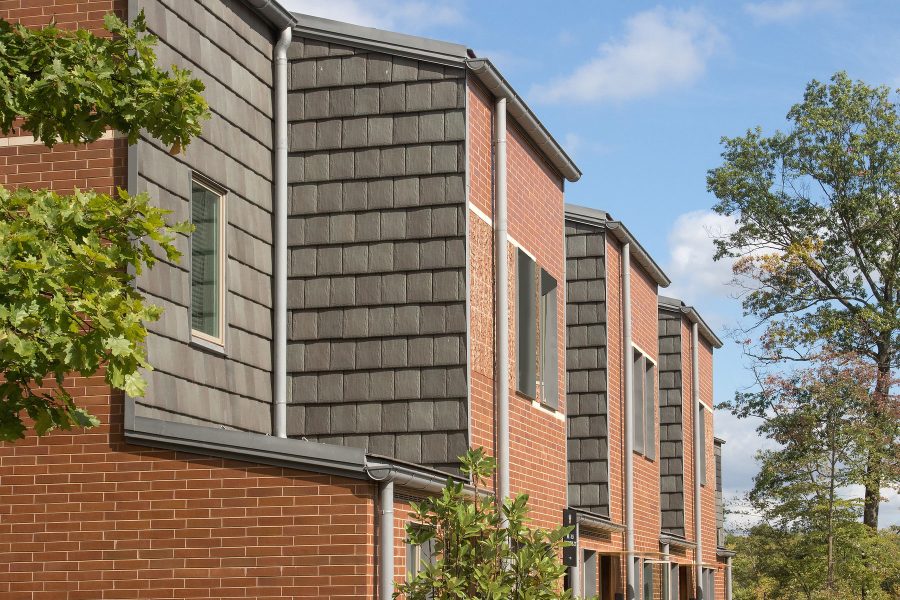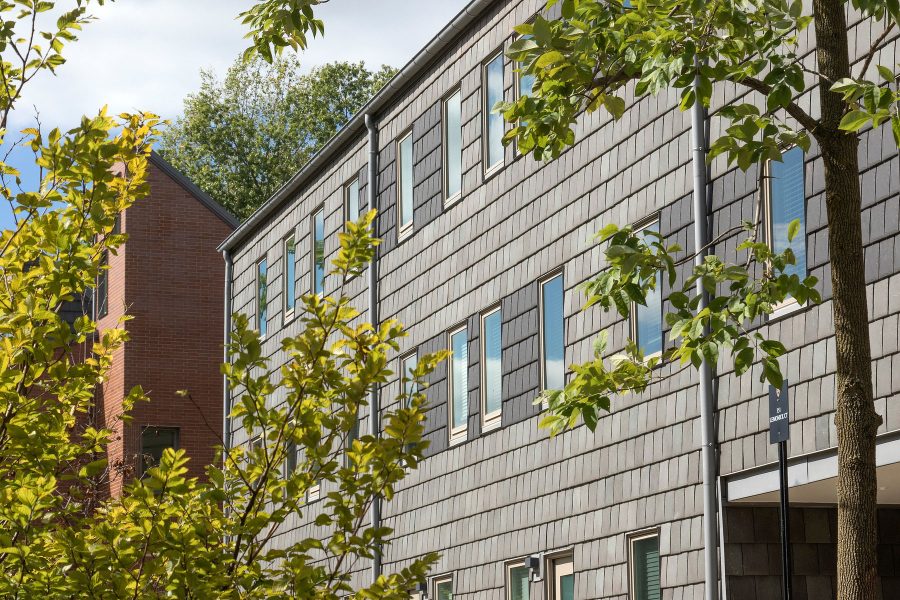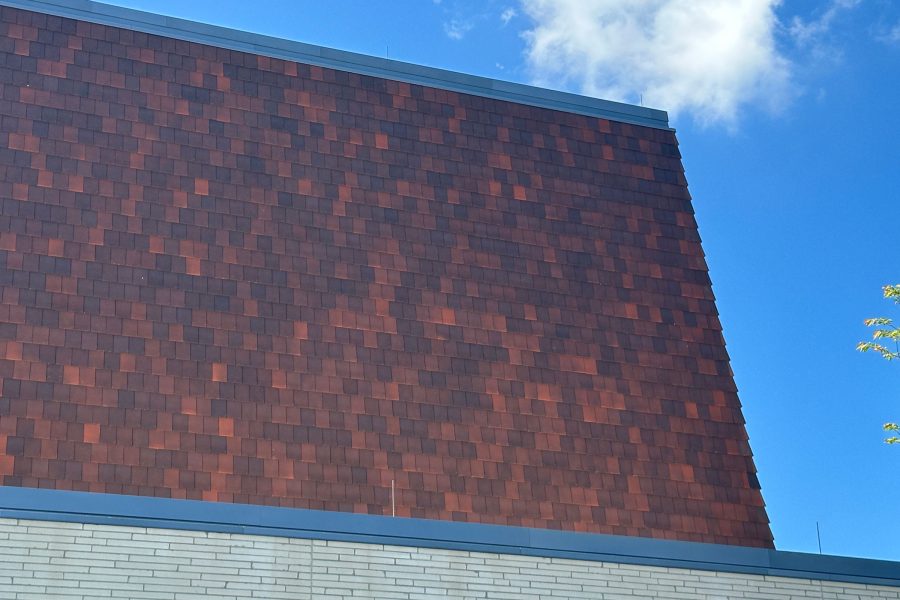Story at a glance:
- Terra-cotta’s life cycle costs and sustainability have captured the interest of a new generation of designers.
- Vanderbilt University constructed new buildings in a Gothic style with terra-cotta roofs that mimic the slate on historic campus buildings.
- Terra-cotta can be customized in color and texture to meet designers’ roofing and wall-cladding visions.
Terra-cotta is experiencing a resurgence. Often considered an “old” building material because of its use on Gothic buildings, the all-natural product—clay and water—is captivating a new generation of designers.
Renewed interest in the material is partially because the buildings roofed during terra-cotta’s heyday 100 years ago are beginning to need refurbishment, according to Dan Harris, vice president of sales and marketing for Ludowici, a manufacturer of terra-cotta since 1888.
“When owners pull the tile off these buildings and see Ludowici on the back, they’re engaging with us because they want to maintain the beauty and longevity they’ve had,” Harris says. “That newfound understanding about terra-cotta’s life cycle costs and sustainability has led to many more new-construction opportunities.”
Case Study: Vanderbilt University

The projects at Vanderbilt use Ludowici’s LudoSlate, a lightweight interlocking terra-cotta tile with chiseled edges and a texture reminiscent of natural slate. Photo courtesy of Ludowici
In the case of Vanderbilt University in Nashville, terra-cotta was chosen for the roofs of four new residential colleges—E. Bronson Ingram College, Nicholas S. Zeppos College, Rothschild College, and Oliver C. Carmichael College. Inspired by adjacent Kirkland Hall, built in 1906, and Alumni Hall, built in 1925, the new residential colleges were designed in the Gothic style and feature similar brick and stonework as the historic buildings. However, rather than being roofed with slate like Kirkland and Alumni halls, the new buildings are topped with Ludowici’s LudoSlate, a lightweight interlocking terra-cotta tile with chiseled edges and a texture reminiscent of natural slate.
The choice hinged on several factors. “Vanderbilt’s move to LudoSlate was partly driven by economics, partly driven by sustainability, and partly driven by just the range of color and texture in which the product is available,” says Derek Marks, associate with David M. Schwarz Architects (DMSAS), design architect on the new colleges. Marks says DMSAS used Ludowici’s terra-cotta on several past commissions and recommended LudoSlate for this project.
Natural slate’s color comes from the chemical and mineral composition of the stone. Quarrying new slate to match Vanderbilt University’s existing slate roofs would have been difficult, but matching terra-cotta to the existing slate in color and texture only required working with Ludowici’s team.
“The process begins when we receive samples of the slate and then match it with a glaze on our terra-cotta,” Harris says. “Clay obviously is clay red, but then we glaze it and kiln-fire it to chemically adhere the color to the tile, making it a color-fast material that’s warranted for 75 years—though it can last much longer.”
While Ludowici’s terra-cotta formulation has not changed since the company was established, Ludowici continues to evolve its products to meet the needs of modern buildings. For example, Vanderbilt University’s new residential colleges feature LudoSlate Premier, a mix of three random-width tiles that can be blended for a staggered appearance, more like slate. LudoSlate is also lighter weight than traditional clay tile and is interlocking, which makes it easier to install.

Terra-cotta was chosen for the roofs of four new residential colleges at Vanderbilt University. Photo courtesy of Ludowici
Marks adds that the LudoSlate on the new residential colleges is dynamic in ways traditional slate is not. “If you see these buildings on a particularly bright day, the LudoSlate is tremendously complementary to the brick blends,” he says. “It has this nice reflective quality to it you don’t necessarily get with a traditional slate. Some of the brick blend also has a reflective quality to it, so the LudoSlate accentuates the patterning in these bricks and gives the buildings a very dynamic and visually interesting appeal.”
DMSAS’ design of the new residential colleges in the Gothic style connects Vanderbilt University to its historic past while attracting eyes along a prominent roadway in Nashville. “The new buildings are along West End Avenue, which runs from Vanderbilt’s campus into downtown,” Marks says. “There were four uninspiring dorm towers probably built in the late 1960s there before. Now the school has a better presence along West End Avenue—and it’s a recruiting tool.”
Terra-Cotta for Modern Designs

Princeton Lakeside Graduate Housing. Photo courtesy of Ludowici

Princeton’s Lakeside Graduate Student Housing uses LudoSlate and NeXclad 16 in a matching gray called Custom Impressionist. Photo courtesy of Ludowici
Ludowici’s willingness to evolve its more than 100-year-old product to meet the demands of modern buildings and designers has also led to it offering NeXclad, small-format terra-cotta wall cladding, through its subsidiary Terreal North America.
“I really think cladding is our future,” Harris says. “Steep-slope roofing isn’t going anywhere, but we’re seeing more public/private programs being put in place on campuses, and the buildings being designed for these programs have flat roofs and curved wall surfaces.”
NeXclad is offered in 14- and 16-inch versions, as well as NeXclad True, which can be installed flush for a sleek look. Like Ludowici’s terra-cotta roofing products, NeXclad is available in a variety of colors and surface textures, as well as carries a 75-year warranty. “Because it’s small format and we can customize the color and texture, designers can transition and blend it with a lot of other materials, like wood, brick, and stone,” Harris says.

The University of Dayton’s Roger Glass Center for the Arts features NeXclad 16 in a sandblasted surface texture with Ludowici’s Sunset Red base color and Ebony Mist added as a secondary shade. Photo courtesy of Ludowici
Just last year the University of Dayton opened its 51,000-square-foot, single-story Roger Glass Center for the Arts, designed by Champlin Architecture. The contemporary building features NeXclad 16 in a sandblasted surface texture with Ludowici’s Sunset Red base color and Ebony Mist added as a secondary shade. The color combination and 3-inch lap with 13-inch exposure make the cladding look like wood shake, which complements the building’s white brick base.
Meanwhile, Princeton University’s new Lakeside Graduate Student Housing features LudoSlate on 100% of the roof area and NeXclad 16, covering 50% of the walls, in a matching gray called Custom Impressionist. The Studio Ma design team had envisioned fiber-cement cladding with synthetic-slate roofing and walls but didn’t like the materials together in mockup. After contacting Ludowici about LudoSlate and learning about NeXclad, the design team liked the aesthetics—and 75-year warranty—of this combination and moved forward with it for the housing project.
At the end of the day, Ludowici says its goal is always to ensure the product it’s been making for more than 100 years meets project requirements. “There are a lot of manufacturers going to fewer products, fewer colors, more robotics,” Harris says. “Ludowici wants to maintain its legacy of making beautiful terra-cotta products, handled by people, here in the US, with textures and colors for any building type—whether they’re ancestral, historic, or modern, new buildings. We don’t want to change.”

